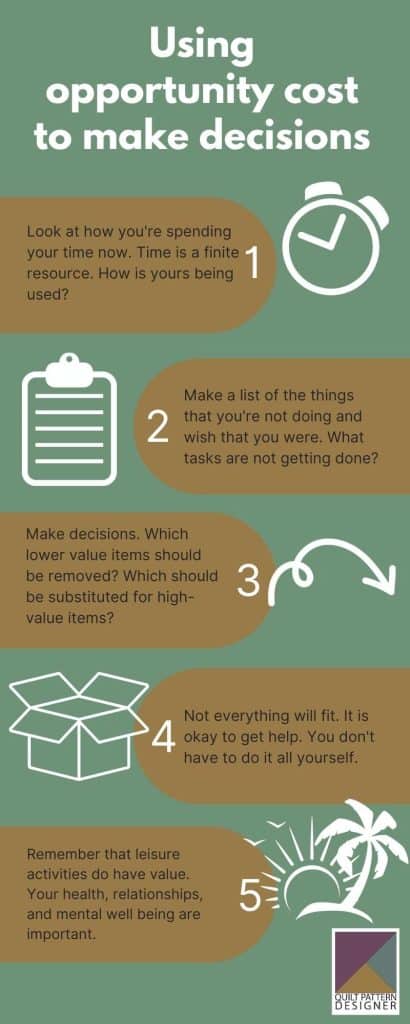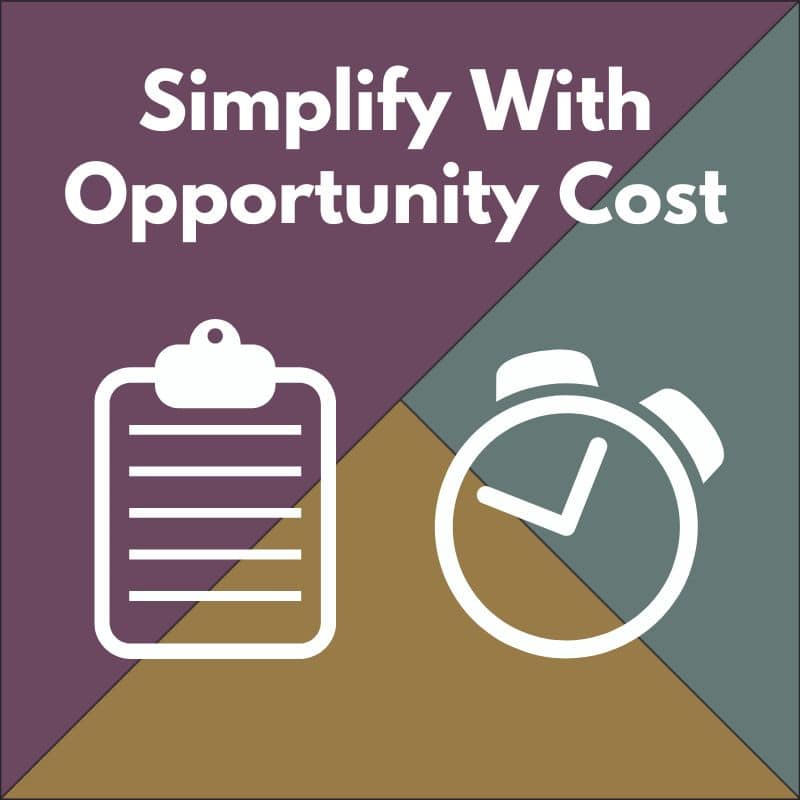As Quilt Pattern Designers, we’re used to DIY – Do it Yourself. Especially when getting started, we are a one-person team who does it all – come up with ideas, sketch out the ideas, figure out how much fabric to buy, write a test pattern, do the quilt math, cut the fabric, piece the quilt, make change notes, enter the changes, find someone to proof the pattern, ask a friend or two to test the pattern, quilt and bind, take photos, edit photos, write the blog post, create the PDF file, create the print file, order the print run, bag the patterns, contact shops and distributors, create the social media posts, write the marketing email, fill the orders, deal with any customer service issues… and then do it all again for the next pattern! I’m going to teach you how understanding opportunity cost can simplify your day.
At the very beginning, the value of all the labor listed above is not much. And that’s not to say that YOU aren’t worth much. You are a diamond. But the work isn’t bringing value to the business yet. You’re bootstrapping.
When you calculate out all the time it took you (let’s say 100 hours), if you sell 50 patterns at $10/pattern, then you’ve made just $5.00 per hour of work … and that’s revenue, not profit! To calculate profit you’d have to subtract the cost of printing, the cost of your web host, any online shop fees (including credit card fees), the cost of fabric, batting, thread, longarming… once you do this math your take-home might be closer to $2/hour!
So why would anyone want to be a quilt pattern designer? Because you get better at streamlining the work. And, hopefully, you grow your sales from just 50 patterns to hundreds or thousands. 50 patterns at $10/pattern is $500. If you can do the same amount of work and sell 500 patterns, you’ve made $5,000 in revenue. 1,000 patterns is $10,000 in revenue… and now your time is as valuable as you are. Which is why you’ll want to simplify with opportunity cost.
How do you create more time?
At some point, you’ll find that you don’t have enough time to do all the things. The first step is to streamline your work – find systems and processes for repetitive tasks. This might be a template for your to-do list, a morning routine that gets you going, or organization to make month-end book keeping less time-consuming.
Then, remove the things that don’t add significant value. Perhaps you don’t need to add a hand-written note to each package you ship. Maybe you can take two trips to the post office each week instead of going each day.
At some point, you may find that you’ve streamlined and stripped down your business as much as you can, and yet you’re still staying up past your bedtime most nights and not getting to all the things you want (or need) to in a day, it may be time to look at bringing on some help
Where does opportunity cost factor in?
Opportunity cost is the cost of the activity you’re doing, as a factor of what you’re not doing, because of this activity. For example, the opportunity cost of you reading this article might be reading your email, scrolling social media, or designing a new pattern. When we look at opportunity costs in business, we consider what our activities are taking us away from. For example, if I’m spending 8 hours a week packing orders, that is 8 hours that I’m not designing a new pattern. Based on your business, you need to decide what your “high value” activities are, and find the best ways to create time for those, while still making sure that the business functions are taken care of.
Now that you understand it, let’s make decisions to simplify with opportunity cost. I might say to myself that the cost of writing a note to each of my customers is just the cost of paper and ink. Or even paper, ink, and my time. But because time is a finite resource, it is also costing me the value of any other work I could be doing instead. If I spend 4 hours a week writing notes, that is 16 hours over the course of a week. In that time I could have a draft of a new pattern. Do my personalized notes bring in enough repeat customers that it is more valuable than writing a new pattern? Depending on your business, that is a judgement call you have to make.
Relaxation time has value
Yes, relaxation time has value. If all you’re doing is working, eating, and sleeping (and sometimes two of those at the same time), you will reach burnout. Just like time and money are finite resources, so is your health. Both your mental health and physical health. If you don’t take care of your body, that can lead to medical problems that will take you away from your business. If you don’t take care of your mental and spiritual self, that can also lead to problems. Mental, physical, spiritual, and relationship problems come up suddenly, unexpectedly, and cause a huge upheaval in the business. There is value in taking time for a walk around the block. And there is value in sitting on the sofa to watch a show with your partner. There is also value in reading a fiction book for fun. Rest is productive.
In terms of opportunity cost, the opportunity cost of being a workaholic may be your health, your relationships, or your mental well being. These have huge value.
Try an opportunity cost analysis on your day
As you go about your day today, think about the tasks that you’re doing, and what you could be doing with this time. Don’t judge yourself too harshly. It is okay to spend time scrolling through social media, chatting with a neighbor, or go out of your way to the “good” coffee shop. But consider which tasks really aren’t worth their opportunity cost, and then find ways to make those changes.

